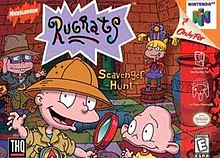
Rugrats is an American animated television series created by Arlene Klasky, Gábor Csupó, and Paul Germain for Nickelodeon. The series focuses on a group of toddlers, most prominently Tommy, Chuckie, Phil, and Lil, and their day-to-day lives, usually involving life experiences that become much greater adventures in the imaginations of the main characters.

All Grown Up! is an American animated television series developed by Kate Boutilier, Eryk Casemiro, and Monica Piper for Nickelodeon. It serves as a sequel to Rugrats, and explores the daily lives of protagonist Tommy Pickles, his little brother Dil and his childhood friends, now tweens/adolescents. The concept for the series was based on the Rugrats episode "All Growed Up", which served as the original series' 10th anniversary special and proved successful with audiences.
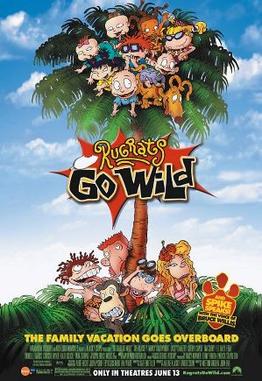
Rugrats Go Wild is a 2003 American animated crossover adventure film based on the Nickelodeon animated television series Rugrats and The Wild Thornberrys. It is the final installment of both the Rugrats and The Wild Thornberrys film series and the sequel to both the films Rugrats in Paris: The Movie (2000) and The Wild Thornberrys Movie (2002). The film was the first to feature Nancy Cartwright as the voice of Chuckie Finster following original voice actress Christine Cavanaugh's retirement in 2001. The film follows the Rugrats and their famillies as they prepare for their planned vacation, but eventually get stranded on an uncharted island in the Pacific, where they meet the Wild Thornberrys for the first time.

The Rugrats Movie is a 1998 American comedy film based on the Nickelodeon animated television series Rugrats. It was directed by Igor Kovalyov and Norton Virgien and was written by David N. Weiss & J. David Stem. The film features the voices of E. G. Daily, Tara Strong, Christine Cavanaugh, Kath Soucie, Cheryl Chase, Cree Summer, Jack Riley, Melanie Chartoff, Michael Bell and Joe Alaskey, along with guest stars David Spade, Whoopi Goldberg, Margaret Cho, Busta Rhymes, and Tim Curry. The film takes place between the events of the series' fifth and sixth seasons, and it follows Tommy Pickles as he and the rest of the Rugrats along with his new baby brother, Dil, eventually get lost into the deep wilderness after taking a high-speed ride on the Reptar Wagon, and embark on an adventure to find their way home in the forest while being pursued by circus monkeys and a predatory wolf along the way. The Rugrats Movie is the first feature film based on a Nicktoon and the first installment in the Rugrats film series.

Rugrats in Paris: The Movie is a 2000 animated comedy film based on the Nickelodeon animated television series Rugrats. It is the second installment in the Rugrats film series and the sequel to The Rugrats Movie (1998). This film marks the first appearance of Kimi Watanabe and her mother, Kira. The film also marks the appearance of the first significant villains in the Rugrats franchise, the child-hating Coco LaBouche and her accomplice, Jean-Claude. The events of the film take place before the series' seventh season, and it focuses on Chuckie Finster as he and the rest of the Rugrats embark on an adventure in Paris, France while he is searching for a new mother.
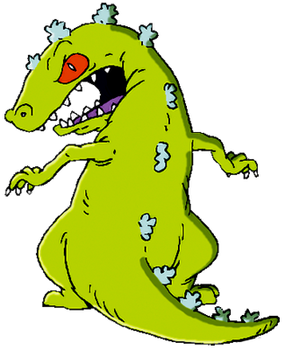
Reptar is a fictional character from the American animated television series Rugrats. It is a green T. rex with rounded, blue spike-like appendages on its back, which intentionally causes it to resemble and spoof Godzilla. Outside of Rugrats-related films, Reptar appears as a playable character in the Nickelodeon Kart Racers and Nickelodeon All-Star Brawl video game series.
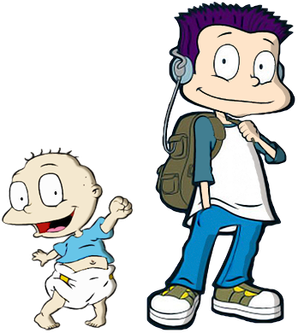
Thomas Malcolm "Tommy" Pickles is a fictional character and the main protagonist of the animated children's television series Rugrats, the reboot, and its spinoff series All Grown Up!. He is also the protagonist of The Rugrats Movie (1998) and Rugrats Go Wild (2003), and a major character in Rugrats in Paris: The Movie (2000), as well as other various Rugrats-related media.
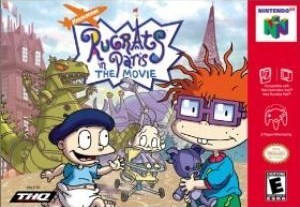
Rugrats in Paris: The Movie is a video game based on the 2000 animated movie of the same name. The game follows the adventures of the Rugrats in a European theme park. A console version of the game was released in 2000, for the PlayStation, Nintendo 64, and a handheld version for Game Boy Color. A version for Microsoft Windows was later released in 2001. The console version's gameplay is similar to Rugrats: Studio Tour, but Paris’ attractions sometimes have minigames too. The handheld gameplay is a side-scrolling platformer. The Windows version's gameplay is an adventure game in which the player must find Chuckie's Wawa Bear.

"All Growed Up" is a special episode of Rugrats and the pilot episode to the spin-off series All Grown Up! that aired on July 21, 2001, on Nickelodeon, to celebrate the series' tenth anniversary. The special serves as the 13th and 14th episodes of the seventh season of Rugrats, and the 143rd and 144th episodes of the series overall. The episode's premise was to focus on what the babies' lives would be like if they were ten years older. The episode proved to be popular enough for a series based on it to be made.
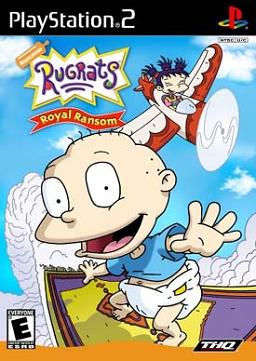
Rugrats: Royal Ransom is an action-adventure game developed by Avalanche Software and published by THQ for the PlayStation 2 and GameCube. The game was released on November 26, 2002, and is based on the Rugrats television series, which aired from 1991 to 2004 on Nickelodeon. The game's plot is loosely based on Rugrats: Castle Capers.
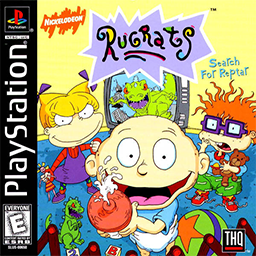
Rugrats: Search for Reptar is a 1998 platform video game developed by n-Space and published by THQ. It was released in North America on November 23, 1998, and in Europe in November 1998 exclusively for PlayStation. Based on the popular Nickelodeon cartoon Rugrats, which aired from 1991 until 2004, the game follows the cartoon's main character, Tommy Pickles, who has lost his Reptar puzzle. It features stages that are typically based on episodes from the television show. It was followed up by Rugrats: Studio Tour, released in 1999 on the same platform.

Rugrats: Totally Angelica is an action video game based on the 1991 Nickelodeon animated children's television series Rugrats. It was developed by Art Co., Ltd and published by THQ for the Game Boy Color (GBC) and PlayStation. The GBC version was released in 2000, while the PlayStation version was published in 2001. It is also the last Rugrats game to be released for the PlayStation and Game Boy Color. A direct sequel for the PC was released in 2002, titled Totally Angelica: Boredom Busters!. It was a point and click adventure game, and was developed by KnowWonder and published by Mattel Interactive.

Rugrats: Studio Tour is a 1999 action-adventure game developed by n-Space and published by THQ. It was released for PlayStation on November 9, 1999, in North America and on December 15, 1999, in Europe. It is based on the Nickelodeon animated television series Rugrats.

The Rugrats Movie is a 1998 platform video game developed by Software Creations and published by THQ. It was released for Game Boy on November 24, 1998, and for Game Boy Color on April 12, 1999, in North America and on April 1, 1999, for Game Boy Color in Europe. It is based on the movie of the same name and the 1991 TV series.

"At the Movies" is the first segment of the third episode of the animated television series Rugrats. It originally aired on the television network Nickelodeon on August 25, 1991, during the series' first season. In the episode, The Rugrats go to a movie theatre to see The Dummi Bears and the Land Without Smiles, but Tommy is infatuated with seeing a monster movie, Reptar!. He and the babies sneak out of the theater room to catch a showing of Reptar! while leaving a wake of accidental mayhem and destruction as they do.
"Runaway Reptar" is a TV movie initially released as the 24th and 25th episodes of the sixth season of the animated television series Rugrats, and the 118th and 119th episodes of the series overall. It originally aired on the television network Nickelodeon on November 27, 1999. The plot follows the babies watching a Reptar movie and imagining themselves as part of the story. It was directed by John Holmquist and Jim Duffy, and was the first two-part episode in the series.

The Rugrats film series is a series of animated comedy-adventure films based on the popular Nickelodeon animated series, Rugrats, created by Arlene Klasky, Gábor Csupó, and Paul Germain. The three films were released in 1998, 2000, and 2003. The first and third films received mixed reviews, while the second received generally positive reviews. The series also experienced declining commercial success with each film.
Rugrats is a Nickelodeon media franchise created by Klasky Csupo consisting of television shows, films, video games, and other entries. It commenced in 1991 with the premiere of the television series of the same name. The franchise revolves around the adventures of a group of toddler friends who learn about the world and their relationship to it.

Rugrats Adventure Game is an educational adventure point and click video game based on the Rugrats television series released for Microsoft Windows and Macintosh on September 30, 1998. It was developed and published by Broderbund. The game follows Tommy Pickles and friends Chuckie, Phil, and Lil as they try to rescue Tommy's beloved toy Reptar from being thrown out as garbage. The game incorporates point and click gameplay, with characters and objects appearing in different locations even after the player has visited them once. Angelica, the series' main antagonist, appears in the game to help further the story and ultimately become the game's main villain.
